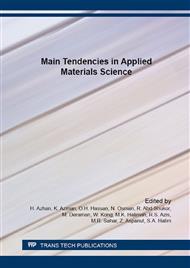[1]
L. M. Zambov, C. Popov, N. Abedinov, M. F. Plass, W. Kulish, T. Gotszalk, P. Grabiec, I.W. Rangelow and R. Kassing, Gas-sensitive properties of nitrogen-rich carbon nitride films, Advanced Materials, 12(9), 2000, pp.656-660.
DOI: 10.1002/(sici)1521-4095(200005)12:9<656::aid-adma656>3.0.co;2-s
Google Scholar
[2]
J. G. Lee, S. P. Lee, Lee, J. G. & Lee, S. P., Surface analysis and humidity-sensing properties of carbon nitride films for microsensors, Journal of the Korean Physical Society, 47, 2005, pp.429-433.
Google Scholar
[3]
F. Ghamouss, P. Y. Tessier, A. Djouadi, M. P. Besland and M. Boujtita, Screen-printed carbon electrode modified on its surface with amorphous carbon nitride thin film: Electrochemical and morphological study, Electrochimica acta, 52(15), 2007, pp.5053-5061.
DOI: 10.1016/j.electacta.2007.02.015
Google Scholar
[4]
Mikmekova, Eliska, J. Polcak, Jaroslav Sobota, Ilona Mullerova, Vratislav Perina, and Ondrej Caha, Humidity resistant hydrogenated carbon nitride films, Applied Surface Science, 275, 2013, pp.7-13.
DOI: 10.1016/j.apsusc.2013.03.033
Google Scholar
[5]
M. Balaceanu, E. Grigore, F. Truica-Marasescu, D. Pantelica, F. Negoita, G. Pavalescu, F. Ionescu, Characterization of carbon nitride films deposited by hollow cathode discharge process, Nuclear Instruments and Methods in Physics Research Section B: Beam Interactions with Materials and Atoms, 161, 2000, pp.1002-1006.
DOI: 10.1016/s0168-583x(99)00957-x
Google Scholar
[6]
S. Muhl, A. G. Couto, J. M. Mendez, S. Rodil, G. Gonzalez, A. Merkulov, R. Asomoza, Production and characterisation of carbon nitride thin films produced by a graphite hollow cathode system, Thin Solid Films, 308, 1997, pp.228-232.
DOI: 10.1016/s0040-6090(97)00377-5
Google Scholar
[7]
M. Othman, R. Ritikos, N. H. Khanis, N. M. A. Rashid, S. A. Rahman, S. M. A. Gani, M. R. Muhamad, Effects of rf power on the structural properties of carbon nitride thin films prepared by plasma enhanced chemical vapour deposition, Thin Solid Films, 519(15), 2011, pp.4981-4986.
DOI: 10.1016/j.tsf.2011.01.065
Google Scholar
[8]
A. Y. Liu and M. L. Cohen, Prediction of new low compressibility solids, Science, 245(4920), 1989, pp.841-842.
DOI: 10.1126/science.245.4920.841
Google Scholar
[9]
L. M. Zambov, C. Popov, M. F. Plass, A. Bock, M. Jelinek, J. Lancok, .. & W. Kulisch, Capacitance humidity sensor with carbon nitride detecting element, Applied Physics A, 70(5), 2000, pp.603-606.
DOI: 10.1007/s003390051088
Google Scholar
[10]
A. Badzian, T. Badzian, R. Roy and W. Drawl, Silicon carbonitride, a new hard material and its relation to the confusion about harder than diamond, c 3 n 4, Thin Solid Films, 354(1), 1999, pp.148-153.
DOI: 10.1016/s0040-6090(99)00535-0
Google Scholar
[11]
T. Malkow, Critical observations in the research of carbon nitride, Materials Science and Engineering: A, 292(1), 2000, pp.112-124.
DOI: 10.1016/s0921-5093(00)00960-6
Google Scholar
[12]
N. Aziz, R. Ritikos, S. Kamal, N. Azman, & R. Awang, Effect of rf power on the chemical bonding and humidity sensing properties of a-cnx thin films, Advanced Materials Research, Trans Tech Publ, (2015).
DOI: 10.4028/www.scientific.net/amr.1107.655
Google Scholar
[13]
K. Teshima, H. Sugimura, Y. Inoue & O. Takai, O, Gas barrier performance of surface-modified silica films with grafted organosilane molecules, Langmuir, 19(20), 2003, pp.8331-8334.
DOI: 10.1021/la034164f
Google Scholar
[14]
J. Robertson, Properties of diamond-like carbon, Surface and Coatings Technology, 50(3), 1992, pp.185-203.
DOI: 10.1016/0257-8972(92)90001-q
Google Scholar
[15]
A. C. Ferrari, & J. Robertson, Interpretation of Raman spectra of disordered and amorphous carbon, Physical Review B, 61(20), 2000, p.14095.
DOI: 10.1103/physrevb.61.14095
Google Scholar
[16]
M. Marton, M. Vojs, E. Zdravecka, M. Himmerlich, T. Haensel, S. Krischok, M. Kotlar, P. Michniak, M. Vesely, R. Redhammer, Journal of Spectroscopy, 2013 (2012).
DOI: 10.1155/2013/467079
Google Scholar
[17]
S. E. Rodil, A. C. Ferrari, J. Robertson, S. Muhl, Infrared spectra of carbon nitride films, Thin Solid Films, 420, 2002, pp.122-131.
DOI: 10.1016/s0040-6090(02)00791-5
Google Scholar
[18]
F. Tuinstra and J. L. Koenig, Raman spectrum of graphite, Journal of Chemical Physics, 53 (3), 1970, pp.1280-128.
Google Scholar
[19]
J. W. A. M. Gielen, W. M. M. Kessels, M. C. M. Van de Sanden D. C. Schram, Effect of substrate conditions on the plasma beam deposition of amorphous hydrogenated carbon, Journal of Applied Physics 82 (5), 1997, pp.2643-2654.
DOI: 10.1063/1.366080
Google Scholar


